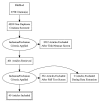Current State and Future Directions of Technology-Based Ecological Momentary Assessment and Intervention for Major Depressive Disorder: A Systematic Review
- PMID: 30959828
- PMCID: PMC6518287
- DOI: 10.3390/jcm8040465
Current State and Future Directions of Technology-Based Ecological Momentary Assessment and Intervention for Major Depressive Disorder: A Systematic Review
Abstract
Ecological momentary assessment (EMA) and ecological momentary intervention (EMI) are alternative approaches to retrospective self-reports and face-to-face treatments, and they make it possible to repeatedly assess patients in naturalistic settings and extend psychological support into real life. The increase in smartphone applications and the availability of low-cost wearable biosensors have further improved the potential of EMA and EMI, which, however, have not yet been applied in clinical practice. Here, we conducted a systematic review, using the Preferred Reporting Items for Systematic Reviews and Meta-Analyses (PRISMA) guidelines, to explore the state of the art of technology-based EMA and EMI for major depressive disorder (MDD). A total of 33 articles were included (EMA = 26; EMI = 7). First, we provide a detailed analysis of the included studies from technical (sampling methods, duration, prompts), clinical (fields of application, adherence rates, dropouts, intervention effectiveness), and technological (adopted devices) perspectives. Then, we identify the advantages of using information and communications technologies (ICTs) to extend the potential of these approaches to the understanding, assessment, and intervention in depression. Furthermore, we point out the relevant issues that still need to be addressed within this field, and we discuss how EMA and EMI could benefit from the use of sensors and biosensors, along with recent advances in machine learning for affective modelling.
Keywords: ecological momentary assessment; ecological momentary intervention; major depressive disorder.
Conflict of interest statement
The authors declare that no competing interests exist.
Figures
References
-
- World Health Organization . Depression and Other Common Mental Disorders: Global Health Estimates. World Health Organization; Geneva, Switzerland: 2017. pp. 1–24.
Publication types
Grants and funding
LinkOut - more resources
Full Text Sources
Research Materials


